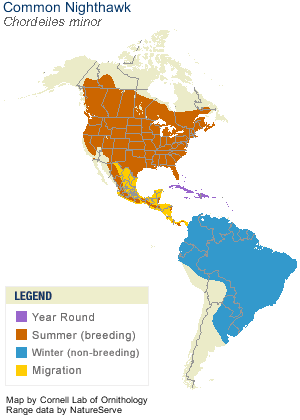Distribution and Migration
Despite what their name suggests, Common Nighthawks are most active during twilight rather than night, and are not closely related to hawks. They are sometimes referred to as bullbats, due to their bat-like flying patterns and the loud whooshing sound they make with their wings. These birds are often observed in flight pursuing insects.

Common Nighthawks have a large breeding range that spans most of continental North America (including the Maritimes), stopping in the northern Canadian territories and extending into Central America. These birds overwinter in South America, most commonly in eastern Peru, Ecuador, and southern Brazil.
Approximately 37% of Common Nighthawk breeding grounds are located in Canada, though only 10% of the population actually breeds in Canada. Within Canada, most individuals breed in southern Labrador.
Breeding and Life History
Common Nighthawks arrive on their Nova Scotian breeding grounds in May. Their breeding season is short, usually lasting only two months. They begin migration to their South American breeding grounds in July and often travel in large groups (numbers in the 1000s).
While in their breeding grounds, males mark their territories by “booming” their wings – pushing wings downward while veering up from a dive. This creates air movement over the wings and a deep sound. This sound also attracts females and may discourage interference by other species. Territories range in size from very small at 4 h, to very large at 259 ha.
Though Common Nighthawks most commonly nest on bare, rocky grounds (rock barrens, open woodland, blueberry fields, and pastures), they also frequently nest in man-made environments such as flat gravel roofs. Instead of building nests, they lay their eggs directly on the ground or occasionally in woody debris. Eggs are hidden by their camouflage colouration. Unfortunately, the lack of protection from a nest leaves eggs vulnerable to predation other bird species (e.g. American Crows and Peregrine Falcons), dogs, raccoons, skunks, snakes, foxes, and other ground-dwelling creatures.


